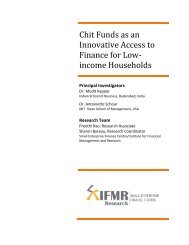Government of India Volume I: Analysis and Recommendations
Government of India Volume I: Analysis and Recommendations
Government of India Volume I: Analysis and Recommendations
You also want an ePaper? Increase the reach of your titles
YUMPU automatically turns print PDFs into web optimized ePapers that Google loves.
PUBLIC DEBT MANAGEMENT<br />
Therefore, the public debt management agency should also carry out cash management,<br />
with a particular focus on its two main components – cash forecasting <strong>and</strong> cash<br />
balancing. Cash forecasting involves participating actively in the forecasting <strong>of</strong> expenditure<br />
<strong>and</strong> revenue, including long-term annual or half-yearly forecasts <strong>and</strong> the short-term<br />
monthly, fortnightly, weekly or even daily internal forecasts. It also means integrating<br />
forecasts <strong>of</strong> receipts <strong>and</strong> payments with other information on cash flows, notably those<br />
generated by financing decisions - bond issuance <strong>and</strong> servicing <strong>and</strong> by the cash manager’s<br />
own transactions.<br />
Cash balancing involves co-ordinating the matching <strong>of</strong> day-to-day expenses <strong>and</strong> revenues.<br />
This includes maintaining a regular channel <strong>of</strong> communication with the Central<br />
<strong>Government</strong>’s banker (i.e., RBI) to estimate end-<strong>of</strong>-day balances. It also requires implementing<br />
a remit from the Ministry <strong>of</strong> Finance regarding managing idle balances. In certain<br />
situations, this might also involve management <strong>of</strong> permanent or structural cash surpluses.<br />
The public debt management agency should also maintain a database (or have access<br />
to the database created by the Ministry <strong>of</strong> Finance for this purpose) <strong>of</strong> the actual<br />
cash balances <strong>and</strong> the liquidity requirements <strong>of</strong> various departments <strong>and</strong> ministries <strong>of</strong><br />
the Central <strong>Government</strong>, including forecasts <strong>of</strong> spending <strong>and</strong> revenue patterns that gets<br />
updated frequently.<br />
12.3.3. Contingent liabilities<br />
Contingent liabilities may be either explicit or implicit, <strong>and</strong> may be issued by either the<br />
Central or State <strong>Government</strong>s. There are close interconnections between contingent liabilities<br />
<strong>and</strong> debt issuance. The invoking <strong>of</strong> guarantees can have a substantial impact on<br />
the risk assessment <strong>of</strong> the public debt structure <strong>of</strong> the Central <strong>Government</strong>. The Commission<br />
is <strong>of</strong> the view that the public debt management agency must manage <strong>and</strong> execute<br />
implicit <strong>and</strong> explicit contingent liabilities. It must evaluate the potential risk <strong>of</strong> these<br />
contingent liabilities <strong>and</strong> advise the Central <strong>Government</strong> on charging appropriate fees.<br />
In addition, the <strong>Government</strong> should be required to seek the public debt management<br />
agency’s advice before issuing any fresh guarantees since this has implications for the<br />
overall stability <strong>of</strong> the public debt portfolio.<br />
The realisation <strong>of</strong> contingent liabilities is counter-cyclical <strong>and</strong> adds to the financial<br />
burden <strong>of</strong> the Central <strong>Government</strong> especially at a time when it is in a crisis situation. Given<br />
this, the public debt management agency should advise the Central <strong>Government</strong> on making<br />
provisions for contingent credit lines with bilateral <strong>and</strong> multi-lateral agreements <strong>and</strong><br />
establish similar credit lines with international agencies.<br />
The management <strong>of</strong> contingent liabilities is a specialised function that involves undertaking<br />
the risk assessment <strong>of</strong> clients. Therefore, the public debt management agency<br />
should be allowed to contract out in part or in entirety the management <strong>of</strong> contingent<br />
liabilities to outside agencies if it so chooses.<br />
12.3.4. Research <strong>and</strong> information<br />
The public debt management agency must adopt a holistic approach that encompasses<br />
the entire liability structure <strong>of</strong> the Central <strong>Government</strong>. This includes not just marketable<br />
debt but also contractual liabilities from public accounts (such as small savings, provident<br />
fund receipts) <strong>and</strong> any other internal liabilities. While these liabilities are part <strong>of</strong><br />
public accounts <strong>and</strong> not a part <strong>of</strong> consolidated funds, they influence the cost <strong>of</strong> raising<br />
debt <strong>and</strong> provide indirect support to the <strong>Government</strong>s.<br />
It is also useful for the public debt management agency to maintain a comprehensive<br />
database <strong>of</strong> State <strong>Government</strong> debt, including information on Consolidated Funds<br />
116 FINANCIAL SECTOR LEGISLATIVE REFORMS COMMISSION



